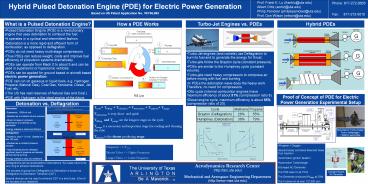Aerodynamics Research Center (http://arc.uta.edu) - PowerPoint PPT Presentation
Title:
Aerodynamics Research Center (http://arc.uta.edu)
Description:
Phone: 817-272-2603 Fax: 817-272-5010 Prof. Frank K. Lu (franklu_at_uta.edu) Albert Ortiz (aortiz_at_uta.edu) Philip Panicker (philipkpanicker_at_uta.edu) – PowerPoint PPT presentation
Number of Views:73
Avg rating:3.0/5.0
Title: Aerodynamics Research Center (http://arc.uta.edu)
1
Phone 817-272-2603 Fax 817-272-5010
Prof. Frank K. Lu (franklu_at_uta.edu) Albert Ortiz
(aortiz_at_uta.edu) Philip Panicker
(philipkpanicker_at_uta.edu) Prof. Don Wilson
(wilson_at_uta.edu)
Hybrid Pulsed Detonation Engine (PDE) for
Electric Power Generation Based on US Patent
Application No. 10/746,863
What is a Pulsed Detonation Engine?
How a PDE Works
Turbo-Jet Engines vs. PDEs
Hybrid PDEs
- Pulsed Detonation Engine (PDE) is a revolutionary
engine that uses detonation to combust the fuel. - It operates in a cyclical and intermittent
fashion. - Detonation is a more rapid and efficient form of
combustion, as opposed to deflagration. - PDEs do not need heavy multi-stage compressors.
- Thus PDEs can reduce weight, costs and improve
fuel efficiency of propulsion systems
dramatically. - PDEs can operate from Mach 0 to about 5 and can
be used in supersonic or hypersonic vehicles. - PDEs can be applied for ground based or aircraft
based electric power generation. - PDE can run on gaseous or liquid fuels, e.g.
Hydrogen, Propane (Natural Gas), Coal Gas,
Kerosene, Diesel, Jet Fuel, etc. - (The US has vast reserves of Natural Gas and
Coal.) - PDE with Hydrogen is the ideal engine of the
future.
- Turbo-Jet engines (and rockets) use Deflagration
to burn its fuel and to generate the energy for
thrust. - Turbo-jets follow the Brayton cycle (constant
pressure). - PDEs are similar to the Humphrey cycle (constant
volume). - Turbo-jets need heavy compressors to compress air
before mixing with fuel and burning. - In PDEs the detonation wave does the heavy work.
Therefore, no need for compressors. - Otto cycle (internal combustion engines) have
maximum efficiency of about 51 (compression
ratio 8). - Diesel engine cycle, maximum efficiency is about
65 (compression ratio of 20).
Proof of Concept of PDE for Electric Power
Generation Experimental Setup
Detonation vs. Deflagration
Tcycle Tfilling Tinitiation Tdetonation
Texhaust Tpurge Tdetonation is very short and
quick Tfilling and Tpurge are the longest stages
in the cycle Tpurge is a necessary and important
stage for cooling and cleaning the tube Texhaust
is the thrust producing stage
- Detonation
- Supersonic, 1000s of m/s
- Modeled as a constant volume process
- Sharp increase in pressure, temperature and
density during detonation - Energy release is rapid and efficient
Zeldovich-von Neumann-Doring (ZND) model Shock
wave followed closely by a reaction zone
Borg-Warner Turbo-charger from a Volkswagen
(1800cc) automobile
- Deflagration
- Subsonic, slow 1-10 m/s, (fastest is a few 100
m/s) - Modeled as a constant pressure process
- High temperatures are released, significant loss
of pressure and density density during burning - Energy release is slow and inefficient
- Propane Oxygen
- Electronically controlled Solenoid Valve Fuel
Injection - Automotive Ignition System
- Automotive Turbocharger
- Compact AC Generator
- The PDE was run at 15Hz
- The Generator produced 6VRMS at 25W
- The Turbine ran at over 127,000 rpm
Frequency 1/Tcycle Shorter Tubes gt Higher
Frequency Longer Tubes gt Lower Frequency
Deflagrations can be accelerated to Detonations.
But tubes have to be very long to achieve
Detonations. The process of going from
Deflagration to Detonation is known as
Deflagration to Detonation Transition
(DDT). Special devices can be used to enhance DDT
in a short tube. (One of the focuses of our
research).
Aerodynamics Research Center (http//arc.uta.edu)
Mechanical and Aerospace Engineering Department
(http//www-mae.uta.edu)
Compact Bicycle AC Generator































